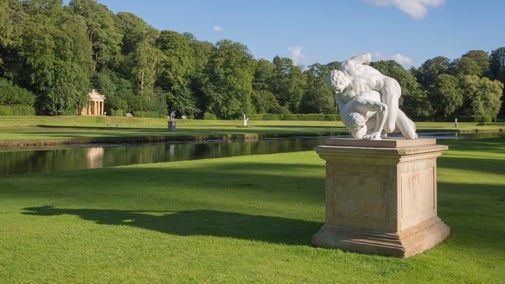
Art and collections
We care for one of the world's largest and most significant collections of art and heritage objects. Explore the highlights, our latest major exhibitions, curatorial research and more.


Throughout history roses have been steeped in symbolism, history and meaning, which you can uncover in the art and collections at the places in our care. Former head curator Dr Sally-Anne Huxtable explains how these delicate and fragrant blooms have been employed to represent love, war, beauty, and purity.
In ancient Greek and Roman cultures, pink roses symbolised their respective goddesses of love, Aphrodite and Venus. As in the miniature copy of Titian’s The Venus of Urbino at Ham House, Surrey, the Roman goddess is often depicted holding these blooms, the petals of which she would scatter over the earth on her travels through the sky in her chariot flown by doves.

One of the ways in which the early Church supplanted pagan religions, such as that of the Romans, was by adapting and repurposing their symbols. In a religion that originally had no female deity, it was not long before the Virgin Mary’s role was elevated to the status of a goddess figure, like Venus and Aphrodite.
One way of doing this was to adopt pagan symbols as part of Marian symbolism and myth. The erotic roses of Venus were transubstantiated into a symbol of Mary’s eternal purity as ‘the rose without thorns’ and of her divine nature as the ‘Rosa Mystica’ (Mystical Rose) with the thorns representing her suffering and grief at Christ’s crucifixion.
From the Middle Ages onwards, roses symbolised the love, purity and grief of the Virgin in religious art and literature. The theme was revived by the pre-Raphaelite, Aesthetic and Symbolist painters in the second half of the 19th and early 20th centuries.
The symbol of the rose was also central to one of the most influential and important secular poems of the Middle Ages. The Roman de la Rose is a 13th-century allegorical French poem of courtly love, started by Guillaume de Lorris and finished by another author, Jean de Meun. The poem was also adapted by Geoffrey Chaucer (and probably two other anonymous authors) as the Romaunt of the Rose, c.1360–70.
The poem takes the form of an allegorical dream vision, a pilgrim’s quest for perfect love which he eventually achieves in the form of plucking a rose from a bush inside the ‘Garden of Pleasure’. In order to enter the walled garden, he must overcome all manner of obstacles. As well as having obvious sexual connotations, the poem is also a manual on the medieval art of romantic love.
In the 15th century, roses took on very different connotations during the series of English civil wars for the English throne between the Royal Houses of York and Lancaster, known as the Wars of the Roses (1455–87).
The House of York was represented by the white rose, and the House of Lancaster by the ‘red’ Apothecary’s rose (in the early modern world, the colour pink was classed as ‘red').
At the conclusion of the wars, with the formation of the House of Tudor uniting both factions, the famous Tudor Rose – with white petals at the centre and red around the outside – was created as a symbol of the new regime.
Possibly following the example of the Tudors, the formidable Bess of Hardwick (1527–1608) chose the wild, Sweet Briar, or Eglantine, rose (Rosa rubiginosa) as part of her Hardwick coat of arms.
Bess of Hardwick's rose can be seen in the incredible 1568 inlaid Aeglentyne (Eglantine) table at Hardwick Hall in Derbyshire, probably commissioned by Bess to commemorate her marriage to George Talbot, Earl of Shrewsbury in 1567.
In the 19th century an intricate language of flowers was created and used in the arts and in popular culture. In symbolic language, roses could take on multiple meanings, with colour further complicating the matter, so that, for instance, yellow roses came to represent jealousy.
Artist Frederic, Lord Leighton, depicts Lady Adelaide Chetwynd-Talbot, Countess Brownlow as a modern Venus in white drapery, clutching a bouquet of pink roses.
In late 19th-century popular culture, roses were firmly established as common symbols of Valentine's Day. A somewhat peculiar card in the collection at Mr Straws House, Nottinghamshire, shows a gnome delivering a rose.
The rose as a symbol of love in all its forms has endured to the present our contemporary culture prizes the ideal of the quest for romantic love devised by medieval literature, such as 'Roman de la Rose', more than almost anything.
Pomanders were typically worn around the neck or suspended from the waist. Most pomanders have hinged compartments which open like segments of an orange; these were used to hold different fragrant herbs or flowers. The pomander in the collection at Dudmaston, Shropshire, is decorated with 'famille rose' enamels depicting chrysanthemums and lotuses.

We care for one of the world's largest and most significant collections of art and heritage objects. Explore the highlights, our latest major exhibitions, curatorial research and more.

From goldwork and gilding to goldsmithing and jewellery making, discover the ways in which gold has been used in the objects in our collections.

We look after the largest collection of tapestries in the UK and one of the largest in the world. Learn more about these status symbols and explore some of the best examples of this craftmanship at the places in our care.

Taking part in sports is a popular pastime all over the world. From the origins of the Olympics to the evolution of cricket, discover sports through the ages at the collections and places we look after.

From 18th-century mini palaces to entire model villages, discover where to find rare and exquisite dolls’ houses in the National Trust’s collection here.